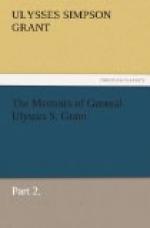CHAPTER XXI.
General Halleck in command—commanding the district of Cairo—movement on fort Henry—capture of fort Henry.
While at Cairo I had frequent opportunities of meeting the rebel officers of the Columbus garrison. They seemed to be very fond of coming up on steamers under flags of truce. On two or three occasions I went down in like manner. When one of their boats was seen coming up carrying a white flag, a gun would be fired from the lower battery at Fort Holt, throwing a shot across the bow as a signal to come no farther. I would then take a steamer and, with my staff and occasionally a few other officers, go down to receive the party. There were several officers among them whom I had known before, both at West Point and in Mexico. Seeing these officers who had been educated for the profession of arms, both at school and in actual war, which is a far more efficient training, impressed me with the great advantage the South possessed over the North at the beginning of the rebellion. They had from thirty to forty per cent. of the educated soldiers of the Nation. They had no standing army and, consequently, these trained soldiers had to find employment with the troops from their own States. In this way what there was of military education and training was distributed throughout their whole army. The whole loaf was leavened.
The North had a great number of educated and trained soldiers, but the bulk of them were still in the army and were retained, generally with their old commands and rank, until the war had lasted many months. In the Army of the Potomac there was what was known as the “regular brigade,” in which, from the commanding officer down to the youngest second lieutenant, every one was educated to his profession. So, too, with many of the batteries; all the officers, generally four in number to each, were men educated for their profession. Some of these went into battle at the beginning under division commanders who were entirely without military training. This state of affairs gave me an idea which I expressed while at Cairo; that the government ought to disband the regular army, with the exception of the staff corps, and notify the disbanded officers that they would receive no compensation while the war lasted except as volunteers. The register should be kept up, but the names of all officers who were not in the volunteer service at the close, should be stricken from it.
On the 9th of November, two days after the battle of Belmont, Major-General H. W. Halleck superseded General Fremont in command of the Department of the Missouri. The limits of his command took in Arkansas and west Kentucky east to the Cumberland River. From the battle of Belmont until early in February, 1862, the troops under my command did little except prepare for the long struggle which proved to be before them.




